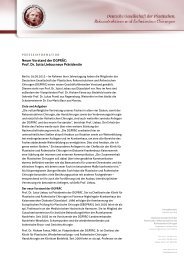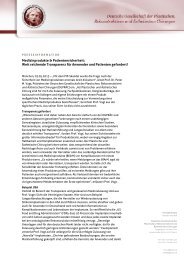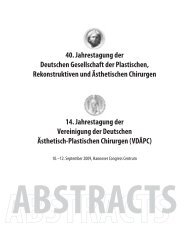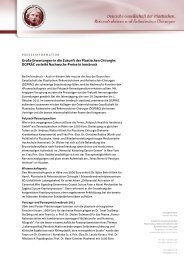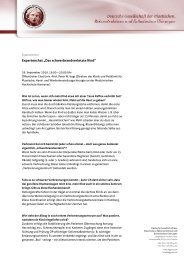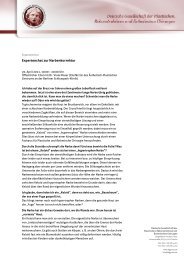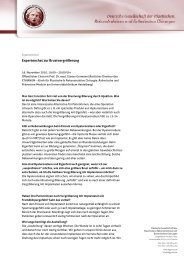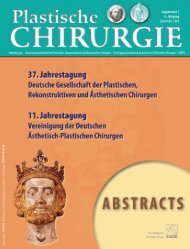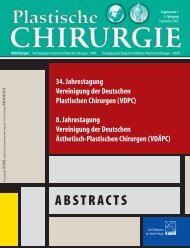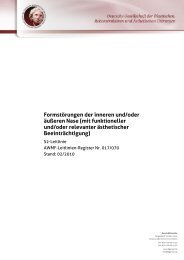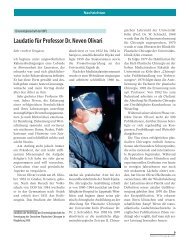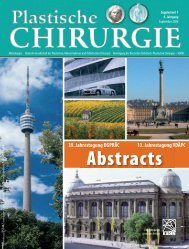Plastische Chirurgie 8: Supplement 2 (2008) - DGPRÄC
Plastische Chirurgie 8: Supplement 2 (2008) - DGPRÄC
Plastische Chirurgie 8: Supplement 2 (2008) - DGPRÄC
Sie wollen auch ein ePaper? Erhöhen Sie die Reichweite Ihrer Titel.
YUMPU macht aus Druck-PDFs automatisch weboptimierte ePaper, die Google liebt.
2.1.3 Exophthalmus – Olivari-Methode 40 Jahre <strong>DGPRÄC</strong><br />
Basierend auf unserer langen Erfahrung und den zahlreichen<br />
Operationen empfehlen wir das Wesselinger<br />
(Olivari) Konzept für die EO-Therapie.<br />
1. In der akuten Phase erfolgt die konservative Behand -<br />
lung mit Steroiden sowie lokalen Maßnahmen. Keine<br />
Orbitabestrahlung.<br />
2. Präoperativ muss der Patient euthyreotisch sein.<br />
Optimal ist, wenn die Operation 1 Jahr nach Beginn der<br />
Erkrankung durchgeführt werden kann.<br />
3. Transpalpebrale Fettentfernung (mindestens 4 ccm<br />
Fett), Infiltration von Dexamethason in die extraokulären<br />
Muskeln<br />
4. Bei Oberlidretraktion Durchtrennung der Levator apo -<br />
neurose sowie des Müller’schen Muskels.<br />
5. Bei Unterlidretraktion Spaltung der Retraktoren und<br />
eventuell Knorpelimplantat.<br />
6. In Ausnahmefällen ist zusätzlich eine 3-Wand-Osteo -<br />
tomie indiziert.<br />
Die beschriebene Methode ist den Osteotomie-<br />
Methoden aus folgenden Gründen weit überlegen:<br />
1. Augenmotilitätsstörungen (Diplopie) sind drastisch<br />
verringert.<br />
2. Visusminderung ist effektiv korrigiert.<br />
3. Die Komplikationsrate ist im Vergleich zur Osteotomie-<br />
Methode gering.<br />
4. Der Bulbus bleibt in der mittleren Lage.<br />
5. Subjektive Beschwerden wie Kopfschmerzen, retrobulbärer<br />
Druck verschwinden kurz nach der Operation.<br />
6. Das kranke Gewebe wird aus der Orbita entfernt.<br />
7. Die psychologische Situation bessert sich dramatisch.<br />
Literatur<br />
1. Jacobson DL, Gange SI, Rose NR, Graham NM (1997)<br />
Epidemiology and estimated population burden of selected<br />
autoimmune diseases in the United States. Clin Immunol<br />
Immunopathol 84: 223<br />
2. Wiersinga WM, Bartalena L (2002) Epidemiology and prevention<br />
of Graves’ ophthalmopathy. Thyroid 12: 855<br />
3. Dyer JA (1976) The oculorotary muscles in Graves’ disease.<br />
Trans Am Ophthalmol Soc 74: 425<br />
90<br />
<strong>Plastische</strong> <strong>Chirurgie</strong> 8 (Suppl. 2) � <strong>2008</strong><br />
4. Bahn RS (2003) Clinical review 157: Pathophysiology of<br />
Graves’ ophthalmopathy – the cycle of disease. J Clin<br />
Endocrinol Metab 88: 1939<br />
5. Heufelder AE (2000) Pathogenesis of ophthalmopathy in<br />
autoimmune thyroid disease. Rev Endocr Metab Disord 1:<br />
87<br />
6. Olivari N (2001) Endocrine orbitopathy. Surgical therapy.<br />
Kaden Verlag, Heidelberg<br />
7. Bradley L, Garrity IA (1999) Surgical management of<br />
Graves’ ophthalmopathy. Endocrinologist 9: 371<br />
8. Olivari N (1991) Transpalpebral decompression of endocrine<br />
ophthalmopathy (Graves’ disease) by removal of<br />
intraorbital fat: Experience with 147 operations over 5<br />
years. Plast Reconstr Surg 87: 627<br />
9. Olivari N (1988) Transpalpebral decompression operation<br />
in endocrine orbitopathy (exophthalmos). Wien Med<br />
Wochenschr 138: 452<br />
10.Melvil G, Wartofsky A, Wartofsky L (1995) Endocrine ophthalmopathy.<br />
In: Becker KL (ed) Principles and practice of<br />
endocrinology and metabolism, 2nd ed. Lippincott,<br />
Philadelphia, pp 385–399<br />
11.Anderson RL, Tweeten IP, Patrinely IR, et al (1989)<br />
Dysthyroid optic neuropathy without extraocular muscle<br />
involvement. Ophthalmic Surg 20: 568<br />
12.Garrity JA, Faourechi V, Bergstrahl EI, et al (1993) Results<br />
of transantral orbital decompression in 428 patients with<br />
severe Graves’ ophthalmopathy. Am J Ophthalmol 116: 533<br />
13.Adenis JP, Carnezind P, Rober PY (2003) Is incidence of<br />
diplopia after fat removal orbital decompression a predictive<br />
factor of choice of surgical technique for Graves’ ophthalmopathy?<br />
Bull Acad Natl Med 187: 1649<br />
14.Eder EF, Richter DF, Olivari N (1999) The technique of the<br />
transpalpebral decompression according to Olivari. Oper<br />
Tech Oculoplast Orbital Reconstr Surg 2: 95<br />
15.Stark B, Olivari N (1993) Treatment of exophthalmos by<br />
orbital fat removal. Clin Plast Surg 20: 285<br />
16.Adenis JP, Rober PY, Lasudry IG, Dalloul Z (1998)<br />
Treatment of proptosis with fat removal orbital decompression<br />
in Graves’ ophthalmopathy. Eur J Ophthalmol 8:<br />
246<br />
17.Ferreira MC, Tuma P Jr, Costa MP, et al (2002) Surgical treatment<br />
of endocrine exophthalmos by removal of orbital fat:<br />
clinical experience. Rev Hosp Clin Fac Med Sao Paulo 57:<br />
217<br />
Prof. Dr. med. Neven Olivari<br />
Hauptstraße 269<br />
51503 Rösrath-Hoffnungsthal





